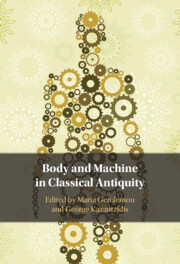Book contents
- Body and Machine in Classical Antiquity
- Body and Machine in Classical Antiquity
- Copyright page
- Contents
- Figures
- Contributors
- An Introduction to Body–Machine Intersections
- Part I Blended Bodies
- Part II The Technological Body
- Chapter 4 Technical Physicians and Medical Machines in the Hippocratic Corpus
- Chapter 5 The Empirical, Art and Science in Hippocrates’ On Joints
- Chapter 6 Hippocrates’ Diseases 4 and the Technological Body
- Part III Towards the Mechanization of the Human Body
- Index of Passages
- General Index
- References
Chapter 4 - Technical Physicians and Medical Machines in the Hippocratic Corpus
from Part II - The Technological Body
Published online by Cambridge University Press: 13 July 2023
- Body and Machine in Classical Antiquity
- Body and Machine in Classical Antiquity
- Copyright page
- Contents
- Figures
- Contributors
- An Introduction to Body–Machine Intersections
- Part I Blended Bodies
- Part II The Technological Body
- Chapter 4 Technical Physicians and Medical Machines in the Hippocratic Corpus
- Chapter 5 The Empirical, Art and Science in Hippocrates’ On Joints
- Chapter 6 Hippocrates’ Diseases 4 and the Technological Body
- Part III Towards the Mechanization of the Human Body
- Index of Passages
- General Index
- References
Summary
While there are some studies on medical tools in antiquity, none of them deals with medical machines. These are mainly depicted in two treatises of the Hippocratic corpus that deal with bone reduction. The texts, On Fractures and On Articulations, which are two of the oldest works in the Hippocratic corpus, are premised on the idea that the body’s treatment is better achieved with rational, practical means that build a relationship of trust between the physician and the patient. Accordingly, the function and use of the Hippocratic machines by physicians is critically approached with a view to investigating the way medical machines interact with this leading doctrine of Hippocratic medicine. By differentiating between Hippocratic bone machines and simple medical tools used in bone reductions, the chapter concludes that bone-reduction machines, in contrast to simple medical tools, are mainly identified through the great amount of power they can release, which could be both beneficial and harmful for the patient, depending, in most of the cases, on the way the physician uses the machine. Moreover, the use of machines, by enhancing the physician’s craft, jostles it; mechanical bone reduction depends less on the physical power of the physician’s body (hands etc.), his knowledge and skill and more on the power of the machine.
- Type
- Chapter
- Information
- Body and Machine in Classical Antiquity , pp. 107 - 125Publisher: Cambridge University PressPrint publication year: 2023



